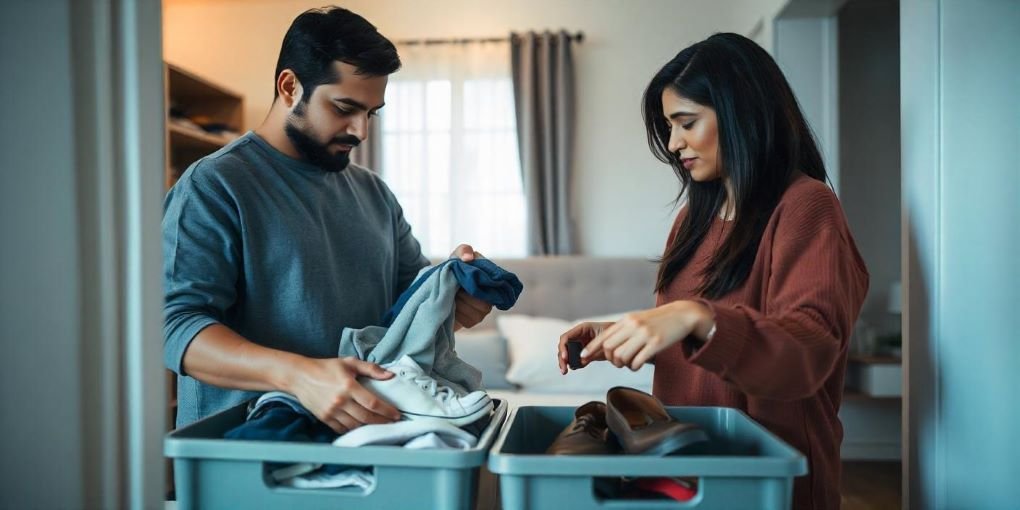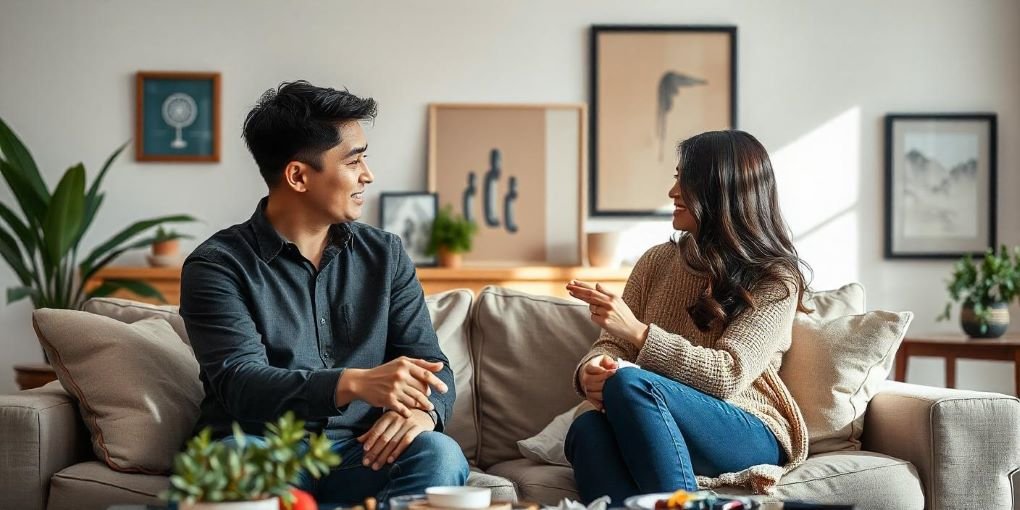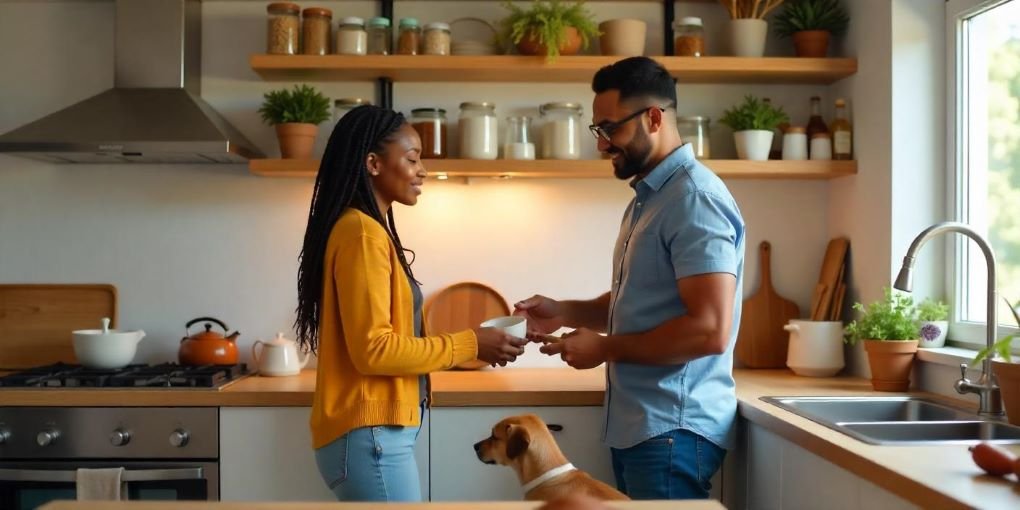Creating a well-organized home as a couple brings a sense of peace and harmony to daily life making shared spaces more enjoyable and functional. Balancing two different preferences routines and habits of creating a well-organized home as a couple brings a sense of peace and harmony to daily life making shared spaces more enjoyable and functional. However balancing two different preferences routines and habits often makes organization challenging. With thoughtful planning and mutual commitment couples can create clutter free environments that promote a more enjoyable home life. This guide offers detailed strategies for home organization designed to reduce clutter improve efficiency and enhance the joy of shared living. Below are comprehensive tips techniques and tools for creating a clutter free home that fosters personal and shared space in this article we will learn about Home Organization Tips For Couples To Reduce Clutter in fully details.
Setting the FoundationWhy Organization Matters
Maintaining a well organized home is more than just aesthetics it directly affects both partners mental and emotional well being. Clutter Stress can lead to reduced productivity and various adverse outcomes. Feelings of overwhelm. On the other hand an organized space enhances comfort efficiency and harmony. For couples organization creates an environment of mutual respect making it easier to navigate daily routines.
Related Read: For tips on organizing specific home spaces visit Nexxity Guide to Functional Home Design.
- Weekly Decluttering Routine for Couples
Establishing a weekly decluttering routine keeps accumulation in check. A set schedule allows couples to focus on specific areas making the process manageable and less overwhelming. Here is a weekly guide to decluttering your home together:
Weekly Decluttering Guide
| Day | Area | Key Tasks |
|---|---|---|
| Monday | Kitchen | Discard expired foods organize the pantry and clean countertops. |
| Tuesday | Bedroom | Review closet fold clothes and organize nightstands. |
| Wednesday | Living Room | Tidy bookshelves organize electronics and clean surfaces. |
| Thursday | Bathroom | Dispose of expired items organize toiletries and wipe surfaces. |
| Friday | Entryway | Organize shoes sort mail and tidy the coat closet. |
| Saturday & Sunday | Relax & Review | Reflect on progress and celebrate small wins together. |
Shared Storage Solutions for Common Areas
Shared areas like the living room kitchen and bathroom can quickly get messy with both partners belongings. Investing in shared storage solutions makes maintaining order in these areas more accessible. Here are some suggestions:
- Multipurpose Furniture: Opt for coffee tables ottomans and beds with built in storage to keep items organized.
- Modular Shelving: These units can be adjusted to fit different-sized items making them ideal for shared storage.
- Drawer Organizers: Use these for utensils makeup or office supplies creating separate sections for each partners belongings.
Read More: Explore Nexxity’s Home Organization Tips.
Labeling for Effortless Organization
Labeling storage areas helps each partner quickly identify where things belong. Use a consistent labeling system across drawers bins and cabinets to minimize confusion and misplaced items.
Personalized Spaces Within Shared Homes
While shared storage is essential it is equally important to have personalized areas that reflect each partners individuality. Personalized spaces can include a workstation hobby area or a drawer or shelf where one partner can store personal items without interference.
- Home Office Setup: If both partners work from home establish separate workstations to minimize distractions.
- Hobby Nooks: Whether it is a small table for painting or a corner for reading, personalized spaces encourage relaxation and self expression.
- Individual Drawers or Bins: Assign storage bins for personal items like mail, stationery, or tech gadgets to avoid cluttering shared spaces.
Additional Resource: Learn more about Home Improvment Tips.
Efficient Closet and Drawer Organization

Closets and drawers become catch-all areas but can be transformed into efficient storage spaces with the right tools. Couples can maximize closet space by using organizational tools such as:
- Slim Hangers: Thin non slip hangers free up space and keep clothes from slipping.
- Drawer Dividers: Perfect for organizing smaller items like socks, accessories and jewelry.
- Stackable Bins: These can be used on closet floors or shelves to store shoes bags or seasonal items.
Closet Organization Tips for Couples
- Divide Space: Dedicate specific sections to each partner’s clothing to avoid confusion.
- Color Code: Organize clothing by color for easy identification and a streamlined look.
- Use the “One In, One Out” Policy: For every new item, discard or donate an older one.
Recommended Reading: Discover Smart Homes Tecnology.
- Embracing a Minimalist Approach in Shared Spaces
A minimalist approach simplifies the organization of shared spaces by reducing unnecessary items. Start by figuring out which items are really important to you, and then get rid of anything that doesn’t work anymore or doesn’t hold any value in your life.
One In One Out Policy
This approach prevents excessive accumulation. Each time a new item is purchased try to remove an older item. This maintains a balanced quantity of possessions and avoids over-cluttering.
- Limit Decor to Essentials: Choose a few meaningful decor pieces rather than crowding surfaces with knick-knacks.
- Invest in Quality Multi functional Items: Minimalism is about functionality and quality. Select items that can serve multiple functions to make the most of your space.
For More Ideas: Check out Low Cost Greenhouse tips.
Daily and Weekly Cleaning Habits for Clutter-Free Living
A consistent cleaning routine minimizes clutter buildup. Establish daily habits to manage surface level clutter and weekly cleaning tasks for deep cleaning. Here is a breakdown:
Daily Habits for a Clutter-Free Home
| Task | Description |
|---|---|
| Clear Counters | Remove unnecessary items and wipe down surfaces. |
| Put Away Clothes | Ensure clothing is folded or hung after wearing. |
| Organize Mail and Papers | Sort mail and place bills or essential documents in designated spots. |
Weekly Deep-Cleaning Checklist
| Area | Cleaning Tasks |
|---|---|
| Kitchen | Clean appliances sweep floors and wipe down cabinets. |
| Bedroom | Change bedding dust surfaces and vacuum or mop floors. |
| Living Room | Vacuum rugs clean furniture and organize remote controls. |
| Bathroom | Scrub shower clean mirrors and disinfect counters. |
Related Resource: For more on maintaining a clean home, visit Keeping Your Home Dust-Free.
8. Creating an Organized Drop Zone
Designating a drop zone near the entrance prevents items like shoes keys and mail from spreading throughout the house. This area is a central spot where both partners can place essentials making it easy to find them when heading out.
Creating a Routine for Long-Term Success

Having a routine is essential for keeping our lives balanced. A tidy and organized home can make this easier. As couples navigate their busy lives they quickly fall back into cluttered habits. You can organize your daily and weekly routines effectively. more fun and easier to manage by staying organized. This will help create a space where you feel comfortable and in control.
Daily Organization Habits
Daily organization habits are simple yet they can significantly impact over time. Implementing a few quick daily tasks can keep clutter at bay and create a sense of accomplishment.
- 10-Minute Tidy-Up: Spend 10 minutes at the end of each day to put items back in their designated places. Set a timer and see how much you can accomplish in a short amount of time.
- Nightly Review: Before going to bed take a moment to review the day. Are there any items that need to be put away? Do a quick sweep of the common areas to keep everything tidy.
- Morning Reset: Take a few minutes to reset your space each morning. Make the bed tidy the bathroom and clear away breakfast dishes to start your day in a clean environment.
Weekly Organization Goals
Setting weekly goals helps couples maintain focus on specific areas of the home. Choose one or two areas each week to concentrate on creating a sense of progress and accomplishment.
Example Weekly Goals
| Week | Goal |
|---|---|
| Week 1 | Organize the kitchen pantry and clean out expired items. |
| Week 2 | Declutter the living room focusing on media and decor. |
| Week 3 | Tackle the bedroom closets and donate items not worn in the past year. |
| Week 4 | Organize personal items in bathrooms and create a cleaner space. |
The Role of Technology in Organization

In todays digital age technology can play a vital role in helping couples stay organized. Several apps and tools can simplify decluttering and maintaining an organized home.
Digital Tools for Organization
- To-Do List Apps: Use apps like Todoist or Trello to create shared task lists. You can assign tasks to each other and keep track of progress.
- Photo Inventory: Apps like Sortly allow you to photograph and categorize your belongings. This can be useful for managing items you have put away in bins or closets.
- Shared Calendars: Google Calendar or other calendar apps can help you organize tasks and declutter sessions keeping both partners accountable.
- Online Donation Services: Platforms like Give Back Box allow you to donate items easily. Print a shipping label pack your items and send them off for donation.
By leveraging technology couples can streamline their organization efforts and reduce the burden of clutter.
Emotional Benefits of an Organized Home
Beyond the practical benefits of organization an organized home can significantly impact emotional well being. Couples often experience reduced stress and improved relationship dynamics when living in a clutter free environment.
How Organization Enhances Emotional Well Being
- Reduced Stress: Clutter can be visually and mentally overwhelming. Couples can create a calming environment that promotes relaxation and tranquility by reducing clutter.
- Improved Communication: Working together toward a shared goal helps build teamwork and better communication. This approach encourages partners to share their needs and preferences making it easier for them to find common ground and compromise.
- Sense of Accomplishment: Completing organizational tasks provides a sense of achievement. Celebrating these victories strengthens the bond between partners.
Mindfulness and Clutter Management
Incorporating mindfulness into your organizations efforts can further enhance the emotional benefits. Please take a moment to reflect on your belongings and consider their significance in your life.
- Gratitude Practices: Express gratitude for the items you choose to keep. This approach encourages a positive way of thinking and helps us avoid collecting things we do not need.
- Mindful Decluttering: Approach decluttering with intention. Rather than simply discarding items evaluate their purpose and how they contribute to your happiness.
Conclusion Home Organization Tips For Couples To Reduce Clutter
Creating and maintaining an organized home as a couple is a journey that requires patience communication and collaboration. By using these simple ideas couples can clear away clutter and create a happier living space that benefits their relationship. Remember that getting organized is a continuous effort commitment and regular check ins are necessary to ensure both partners stay focused on their goals.
Ultimately the reward is a home that reflects both partners values reduces stress and fosters a supportive and loving atmosphere. Begin with simple steps keep going steadily and savor the experience together. Celebrate your progress communicate openly about needs and preferences and remember that every small step brings you closer to a clutter free home.

How often should we revisit our organizational systems?
It is beneficial to review your organization systems every few months or whenever you notice that clutter is starting to build up again. Regular evaluations help ensure that your systems are still effective and adapt to any changes in your lifestyle.
What are some budget-friendly organization tips?
Look for multipurpose storage solutions such as repurposing old boxes or containers. Thrift stores often have affordable organizing items. Additionally get creative by making your own labels or using household items like mason jars for storage.
How can we maintain motivation to stay organized?
Keep the momentum by setting small achievable goals and celebrating each accomplishment. Sharing your progress with friends or on social media can provide additional encouragement. Joining online communities that focus on minimalism and organization can also offer continuous inspiration.
What if my partner and I have different organizational styles?
Open communication is key. Discuss your preferences and try to find common ground. Compromises like having separate spaces for personal items or rotating duties may help align your efforts. Utilize the strengths of each partner ensuring your individual styles are respected.
How can we maintain our home organization with children?
Involve children in the organizing process by creating fun engaging systems tailored for them. Use colorful bins labels and charts that match their interests making organization a game rather than a chore. Encourage them to participate in regular clean up sessions.
How can we start decluttering our home together as a couple?
Start by choosing one room or area to focus on, such as the living room or kitchen. Set aside dedicated time to go through items together. Use the “keep, donate, recycle, and trash” method to categorize belongings. Establish ground rules for decision-making, ensuring both partners feel heard and respected.
What if we have different opinions on what to keep or get rid of?
It’s common for couples to have differing opinions about items. To navigate this, communicate openly and respectfully. Consider implementing a “cooling-off” period where you agree to revisit certain items later. You can also establish criteria for keeping items based on usefulness, emotional value, or frequency of use.
How often should we check in on our organization progress?
Schedule regular check-ins at least once a month to evaluate your progress. Use this time to discuss what’s working, what’s not, and make adjustments as needed. Celebrating small wins can keep both partners motivated and accountable.
How can we involve children in the decluttering process?
Involve children by making decluttering a fun family activity. Encourage them to choose toys or clothes they no longer use. Teach them about the importance of organization and donating items to those in need. Create a reward system to make it more engaging, such as a small treat for each bag of items donated.
How can we make decluttering less overwhelming?
Break the process into smaller tasks. Instead of decluttering an entire room, tackle one drawer or shelf at a time. Set a timer for 15-30 minutes to keep the process manageable. Focus on making quick decisions to prevent overthinking, and remind yourselves that progress is what matters.

Absolutely The right lighting can truly make a big difference. By strategically placing lamps or using softer, warm-toned lights you can enhance the ambiance and make a small room feel much cozier and more inviting. It is amazing how much lighting can transform a space.